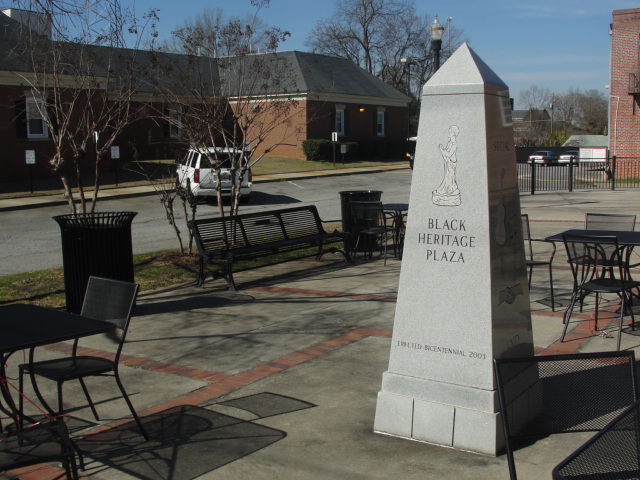Plaza commemorates Milledgeville’s African-American history
Published 1:24 pm Monday, February 6, 2017

- In 2003 the space next to the Allen’s Market Building officially opened as a part of the city’s bicentennial.
MILLEDGEVILLE, Ga. — Since Milledgeville’s founding in 1803, the section of McIntosh Street between Wayne and Wilkinson has undergone many changes. What is now a police station and a parking deck just a stone’s throw away from Georgia College was once a collection of buildings nestled in the heart of the original city grid, playing host to generations of residents, business owners and visitors as the city of Milledgeville slowly grew around it.
“[McIntosh] was the African-American business district for a long time,” said Brian Renko, executive director of Milledgeville’s Allied Arts, whose office sits at the corner of McIntosh and Wayne. “The buildings fell into disrepair and the city purchased the land and put the police department there, and Allied Arts ended up with the Allen’s Market building and the plaza property. We renovated the Allen’s Market building back in the ‘90s, and that’s kind of how the street became what it is now.”
Trending
For years, this section of McIntosh Street, known widely by residents as “The Strip,” existed as the most significant collection of black-owned businesses in Milledgeville. Equipped with everything from barbershops and drug stores to bars and restaurants, The Strip served as the de facto center of black commerce and social life in the city for much of the 20th century. The current Allen’s Market Building, in fact, was built in 1911 as the original site of Slater’s Funeral Home (although no longer owned by the Slater family, the business operates today on the corner of Wayne and Montgomery, less than a block away from its original site). From the turn of the 20th century and onward, The Strip served as a vibrant destination for the city’s black residents until around the mid-1970s. Although little physical evidence of The Strip remained by the time the city celebrated its bicentennial in 2003, the impact that the former black business district had on Milledgeville’s history was enough to spur local residents to call for a permanent monument to commemorate the city’s black history.
“The Black Heritage Plaza was a project that was started when former Mayor [Floyd] Griffin was in office, and we had an idea to do something with the green space that is now Black Heritage Plaza,” said Renko. “We did it in the style of what was then the first phase of streetscape so it would fit in with all of downtown. … We had committees that were set up to help us guide what the Plaza was going to look like, and that was made up of community members as well. It wasn’t just the mayor and Allied Arts, but a community-wide effort.”
Armed with a grant from the Knight Foundation to renovate the space and a stone obelisk commissioned by then-Mayor Griffin, Allied Arts set out to make the proposed space a reality. In 2003 the space next to the Allen’s Market Building officially opened as a part of the city’s bicentennial. Since then, the Plaza has hosted a wide variety of concerts, performances and community gatherings, all the while standing as an immovable reminder of black history in Milledgeville.
“We’ve had everything from musical performances to theater performances out there,” said Renko. “Our after-school theater program for youth, Milledgeville ACT, has performed out there quite a bit. Maria Howell and Ken Trimmins are two well-known and well-respected black jazz artists in the state, and they performed there a few years back. We had a rainstorm that same day, and everyone got up underneath the tent, and we were still playing music — it’s a pretty intimate setting.”
In keeping up the space around the Black Heritage Plaza, Renko and his colleagues at Allied Arts hope to see the space flourish for years to come. While the space serves as a fitting reminder of black history on McIntosh Street and around Milledgeville, the Allied Arts director said he is simply pleased to see community members take advantage of the space.
“We use it periodically when weather permits,” said Renko of the space. “We don’t have a set schedule for the Plaza like we do for the market just because of weather, but … I see people almost every day sitting at the tables and on the benches, so it gets used quite a bit.”





